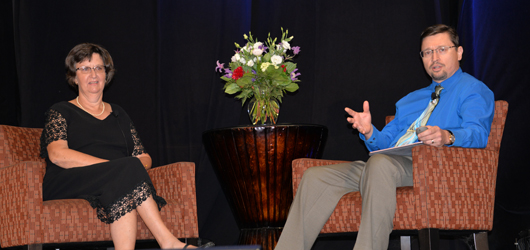
2016 Sunflower Rev-It-Up for Parkinson’s Symposium & Expo.
George Mandybur, MD, calls it the Goldilocks theory of deep brain stimulation (DBS) surgery. Patients who undergo the procedure for Parkinson’s disease don’t want to have a major surgical procedure too early in the course of their disease, when medications are still working well. And they don’t want to have it too late, when the surgery’s benefits might be minimal. “They want to choose the time that is ‘just right,’ ” says Mandybur, a neurosurgeon with Mayfield Brain & Spine. “It’s a personal decision made by the patient, the neurologist, and the surgeon.”
Dr. Mandybur discussed the decision process with one of his patients, Ann Edelen, at the 2016 Sunflower Rev-It-Up for Parkinson’s Symposium & Expo. Ms. Edelen told a riveted audience of several hundred that her timing had been, in fact, “just right.”
Ms. Edelen made the decision to have DBS surgery when she felt it was her only hope for regaining control over her life. Her medications had already been adjusted, and now she was taking so many that she could no longer function. “I had every symptom,” she recalled. Her feet were “freezing to the floor.” She had trouble getting out of a chair. She was taking 18 pills a day, cycling on and off every three hours. She was having nightmares, vomiting at night.
There was also the problem of grocery shopping. “Before surgery, I was on a walker,” she said. “I was going to the Kroger in the little buggy. That was a real trip. I took out three displays. With Parkinson’s disease, your hands are moving, your legs are moving. After that, my daughter said, I’ll go for you; give me a shopping list.”
Many qualify, but only a minority say yes
People who are candidates for DBS surgery are generally those who are getting less and less benefit from medications, Dr. Mandybur said. “They are seeing lots of dyskinesias. Their symptoms are starting to get in the way of life.”
Nevertheless, only a small fraction of those who would benefit from DBS surgery actually undergo the procedure. Dr. Mandybur estimates that 50,000 to 200,000 people in the United States are candidates for DBS at this very moment, and yet a total of only 140,000 cases of DBS have been performed worldwide.
Why so few? The procedure is not experimental. The U.S. Food and Drug Administration approved it in 1997, nearly 20 years ago. And its effectiveness has been documented extensively in peer-reviewed journals by clinical researchers. In fact, the FDA recently approved DBS as a treatment that can be used earlier in the course of Parkinson’s disease. “Intervening earlier may be more beneficial in the long run,” Dr. Mandybur said.
One deterrent has been the prospect of having surgery while awake. For decades DBS surgery has been done this way so that doctors could confirm that the electrodes – implanted in an area of the brain the size of a jelly bean – were in the right spot. Patients can actually hear the electrical activity in their brain cells while the surgeon is threading the electrodes toward the subthalamic nucleus.
Today, patients can have the surgery performed while they are asleep at select hospitals that have intraoperative MRI technology. Dr. Mandybur has performed 10 asleep DBS cases on adult patients at Cincinnati Children’s Hospital Medical Center. (Patients who have a pacemaker or who have already undergone DBS surgery on one side may not be able to have the asleep procedure.)
DBS surgery takes about four hours to complete. But Ms. Edelen, even though she was awake, remembers her experience as taking “about 15 minutes.”
Today, three years after her surgery, Mrs. Edelen enjoys a greatly improved quality of life. She takes only three pills a day, down from 18, and her nightmares have vanished. “I can drive and I can clean my own house,” she says. “It’s almost like I don’t have Parkinson’s.”
— Cindy Starr